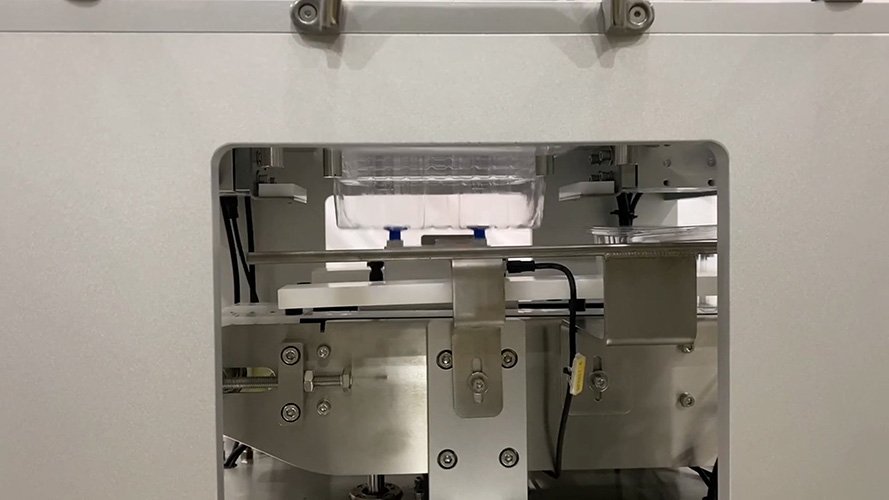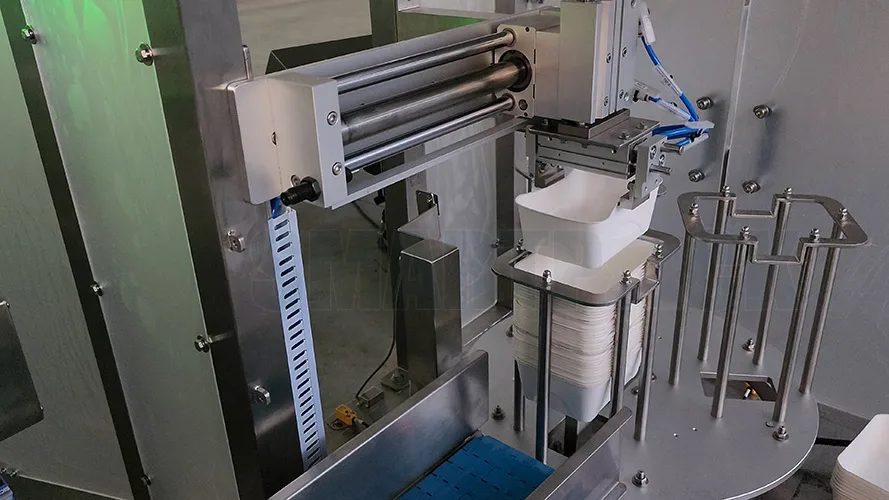Introduction: From Manual Hassles to Automated Solutions
In many food packaging operations, denesting trays or cups remains a manual, time‑consuming chore. Workers must pry apart tightly nested stacks, placing each container onto the line by hand. This approach is slow, labor‑intensive, and error‑prone—leading to line stoppages, bruised product, and rising labor costs.
Automated tray and cup denesters eliminate these pain points by precisely separating and presenting one container at a time. Whether using vacuum suction, mechanical peeling, or robotic pick‑and‑place, denesters integrate seamlessly into your line, delivering consistent, high‑speed feeding. The result is a safer, faster, and more cost‑effective packaging operation that scales with demand and preserves product quality.
What Are Tray and Cup Denesters?
- Tray Denesters: Machines that singulate flat trays or clamshell containers from nested stacks and place them horizontally onto a conveyor or filler. Common applications include ready‑meal trays, bakery clamshells, and meat trays.
- Cup Denesters: Systems designed to dispense paper, plastic, or foil cups, tubs, or bowls from vertical stacks. They feed containers into pockets, chutes, or onto conveyors for filling. Typical uses include yogurt cups, salad bowls, and hot‑drink cups.
Key Differences:
- Orientation: Trays are typically picked and placed horizontally; cups are released vertically into indexing fixtures.
- Mechanism: While both types can use vacuum or mechanical methods, cup denesters often rely on gravity‑assisted hoppers or multi‑stack magazines, whereas tray denesters may use peel‑style fingers or rotating screws.
- Applications: Tray denesters excel with rigid, flat containers; cup denesters handle deeper, cylindrical or bowl‑shaped packages.
By understanding these distinctions, you can select the ideal denester for your package format and line requirements.
Types of Denesters Smartpack Offers
Vacuum Denesters

Mechanism: Suction cups pick the top container from the stack and place it onto the line.
Ideal For: Delicate trays, clamshell, bowls, and containers that easy seperate.
Advantages:
- Gentle handling prevents bruising or deformation
- Quick format changes by swapping suction‑cup arrays
- Handles irregular or lightweight containers
Mechanical Denesters

Mechanism: Blades, or fingers mechanically peel containers from the stack.
Ideal For: Rigid trays or cups with well‑defined rims or stacking features.
Advantages:
- Robust, high‑speed operation
- Effective on oily, dusty, or tightly nested packages
- Minimal reliance on compressed air or vacuum systems
Each Smartpack denester is built with food‑grade materials, intuitive controls, and sanitation‑friendly designs. Whether you need a dedicated high‑speed unit or a versatile robotic cell, Smartpack has a solution to match your output, container type, and line configuration.
Case Study
Benefits of Automated Denesting in Food Packaging
Automating denesting transforms your operation across multiple dimensions:
Labor Savings & Cost Reduction
Replace multiple manual operators with a single denester, cutting labor expenses by up to 40 %. Your frontline staff can focus on quality‑control and higher‑value tasks rather than repetitive feeding.
Increased Speed & Throughput
Denesters process 20–60+ units per minute, far outpacing manual handling. Faster feeding keeps downstream fillers and sealers running at full capacity, boosting overall line output.
Enhanced Safety & Ergonomics
Removing repetitive bending, reaching, and gripping reduces the risk of musculoskeletal injuries. Operators oversee the machine from a safe distance, minimizing exposure to moving parts.
Improved Hygiene & Food Safety
Reducing human contact with trays or cups lowers contamination risk. Most denesters feature stainless‑steel construction and washdown‑rated components for easy cleaning and compliance with food‑safety standards.
Consistency & Waste Reduction
Automated singulation virtually eliminates double‑feeds, jams, and misalignments. Consistent placement improves fill accuracy, reduces damaged containers, and decreases product waste.
These benefits deliver a strong business case for investment, with many operations achieving payback in under 12 months through labor savings and increased productivity.
ROI & Total Cost of Ownership
Automated denesters are capital investments that deliver rapid returns:
- Labor Savings: Eliminating 2–4 manual feeders can save tens of thousands of dollars annually in wages and benefits.
- Increased Revenue: Higher throughput means your line can process more product per shift without added labor costs.
- Waste Reduction: Precise singulation cuts damaged containers and product loss, preserving margin.
- Safety & Compliance: Fewer injuries and contamination events reduce insurance and recall risks.
Most customers recoup their denester investment within 6–18 months, then continue to enjoy pure savings. Smartpack’s machines are engineered for durability and low maintenance, keeping unplanned downtime—and service expenses—to a minimum. When planning your total cost of ownership, include purchase price, annual maintenance, energy use, and spare‑parts stocking; you’ll find that the continuous productivity gains far outweigh these costs over the machine’s lifecycle.
Key Selection Criteria
When evaluating denester options, focus on:
- Throughput Requirements
Ensure the machine’s rated cycle speed meets or exceeds your peak line capacity, with headroom for future growth. - Container Compatibility
Verify minimum/maximum dimensions, material types (plastic, paperboard, foil), and nesting characteristics. - Sanitation & Hygiene
Look for washdown‑rated, stainless‑steel construction and tool‑free disassembly for easy cleaning. - Changeover Flexibility
Assess how quickly you can switch between container sizes—key for mixed‑SKU operations. - Integration & Footprint
Confirm the denester fits within your line layout and interfaces seamlessly with conveyors, fillers, and downstream equipment. - Supplier Support & Reliability
Partner with a vendor offering training, spare parts, and responsive service to ensure sustained performance.
By weighing these factors, you’ll choose a denester that aligns perfectly with your operational goals and packaging formats.
Installation & Maintenance
- Professional Commissioning
Have Smartpack technicians align, calibrate, and synchronize the denester with upstream and downstream equipment for optimal performance. - Operator Training
Equip staff with hands‑on instruction in loading, parameter adjustment, alarm response, and basic troubleshooting. - Routine Cleaning
Incorporate quick daily wipe‑downs and weekly deeper sanitation into your CIP schedule. Focus on suction cups, guides, and sensor areas. - Preventive Maintenance
Follow recommended intervals for replacing wear parts—suction cups, O‑rings, bearings—and keep critical spares on hand. - Settings Management
Document optimal parameters for each container format and back up recipe files (for PLC‑controlled or robotic systems).
Consistent application of these practices maximizes uptime, extends machine lifespan, and safeguards ROI.
Contact Smartpack
Manual denesting is a bottleneck; automation is the solution. Smartpack’s guide has shown how tray and cup denesters:
- Slash labor costs
- Supercharge throughput
- Enhance safety and hygiene
- Deliver rapid ROI
Ready to transform your packaging line?
- Contact Smartpack for a personalized consultation and live demonstration.
- Request our Denester Selection Checklist to compare models and features.
- Get a Free ROI Analysis tailored to your production volume and labor rates.
Don’t settle for manual feeding when you can package with precision, speed, and confidence. Partner with Smartpack—your trusted global supplier—to elevate your food packaging operation today.
